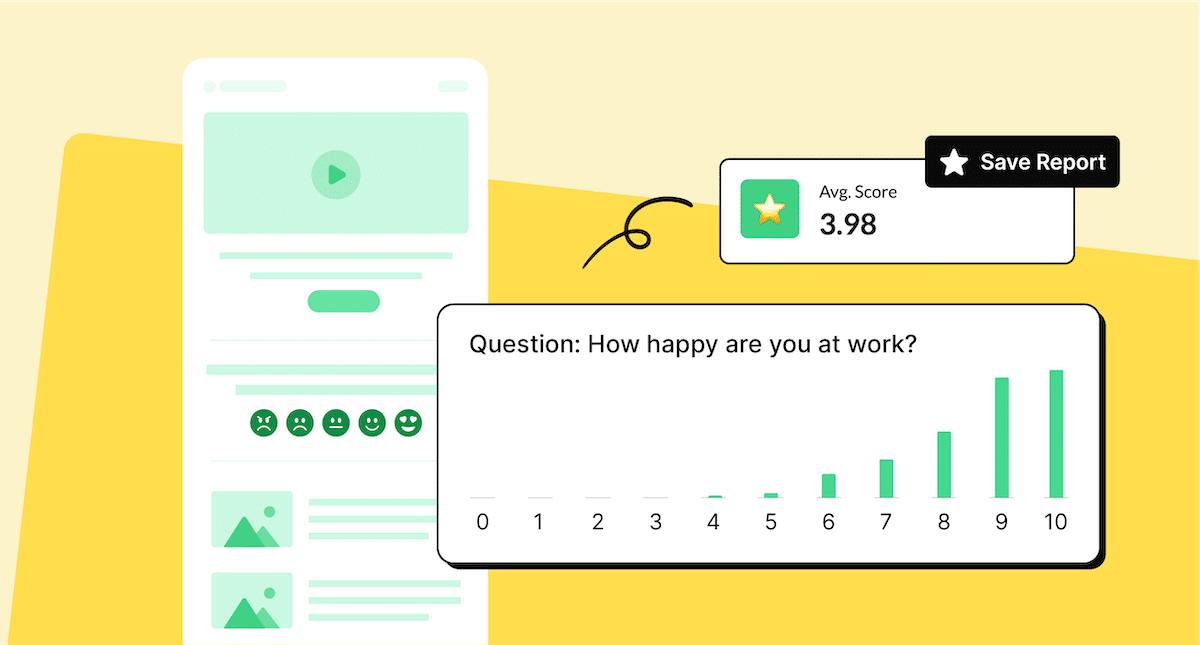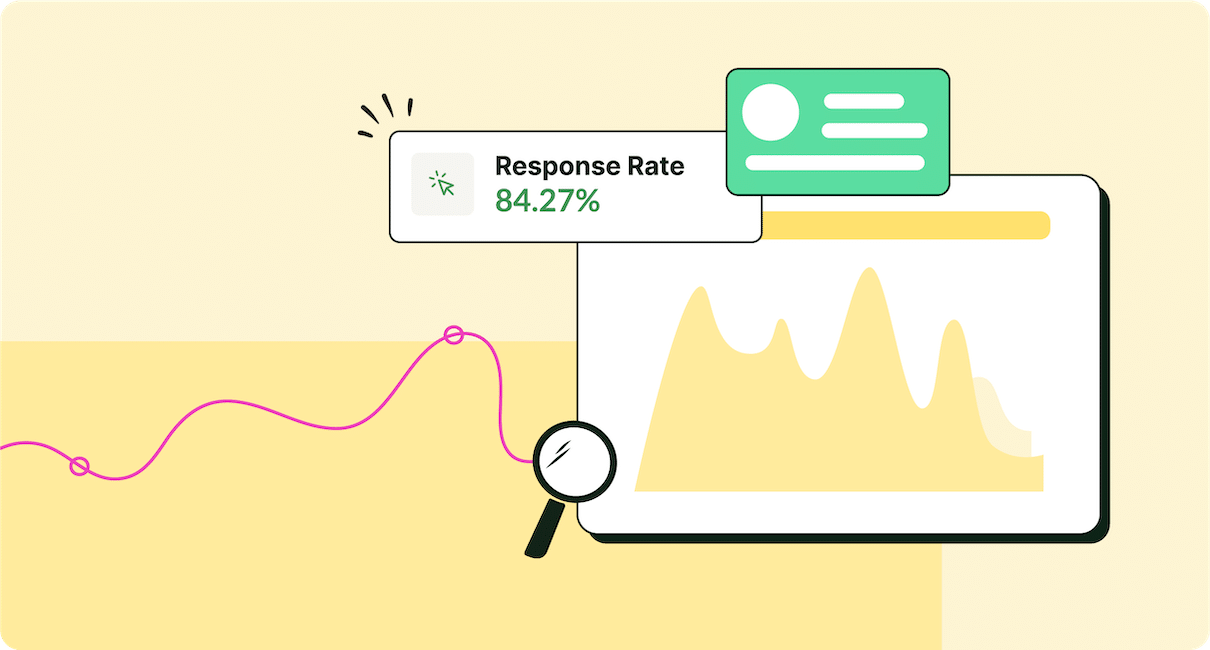Employee feedback surveys can seem deceptively simple. Sure, getting employees to answer some questions is easy enough. But getting honest, actionable feedback? Well, that’s another story.
To collect valuable data, you must carefully craft your employee feedback survey and questions. In this article, we’ll delve into the intricacies of employee feedback surveys and offer expert advice on writing questions that elicit candid, useful responses.
We’ll also provide tips on creating and distributing employee feedback surveys for maximum engagement and how to best track and analyze the results. Read on to learn how to get the most out of your staff surveys!
Take a self-guided tour of ContactMonkey
See how our key features can streamline your internal communications.
Take product tour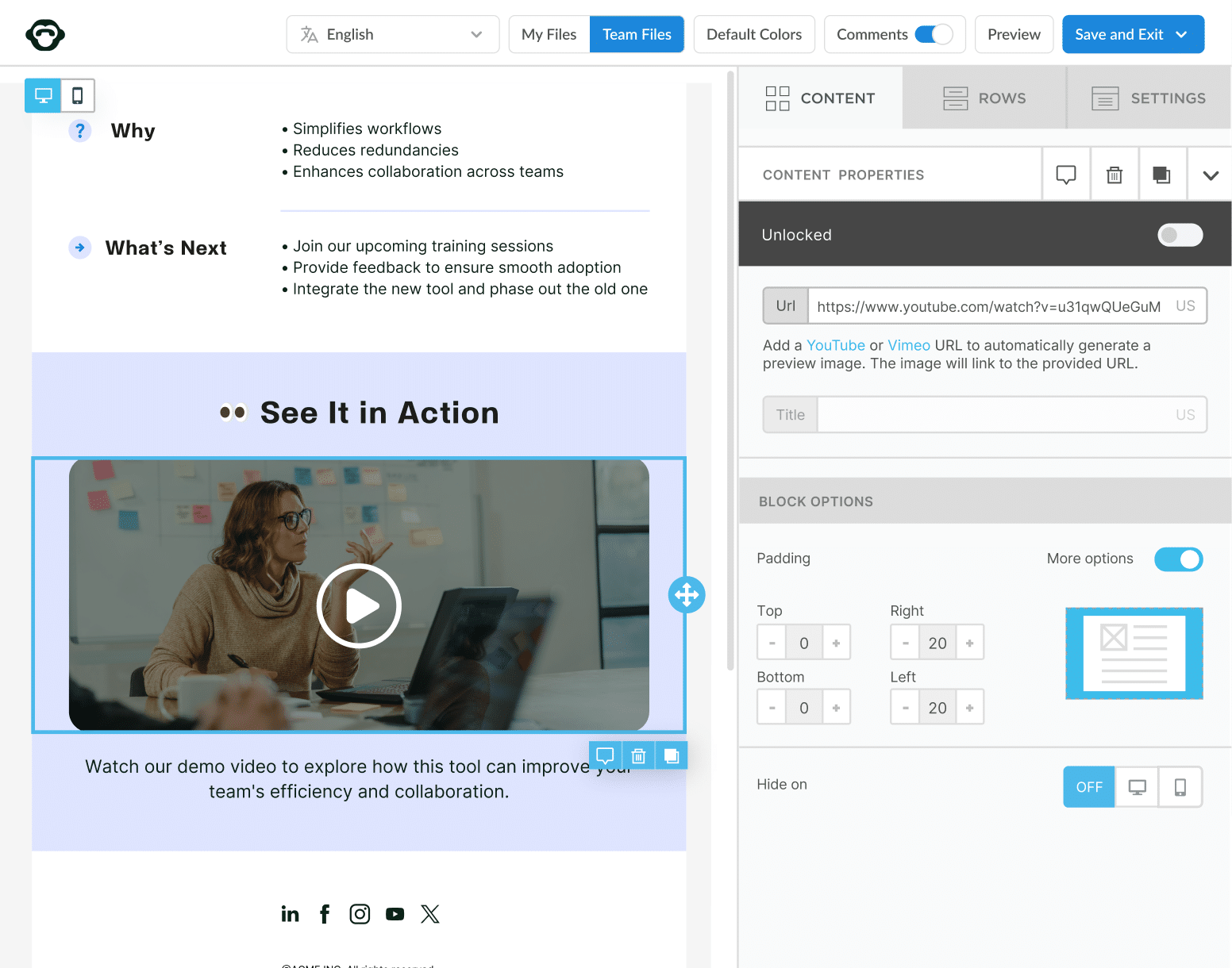
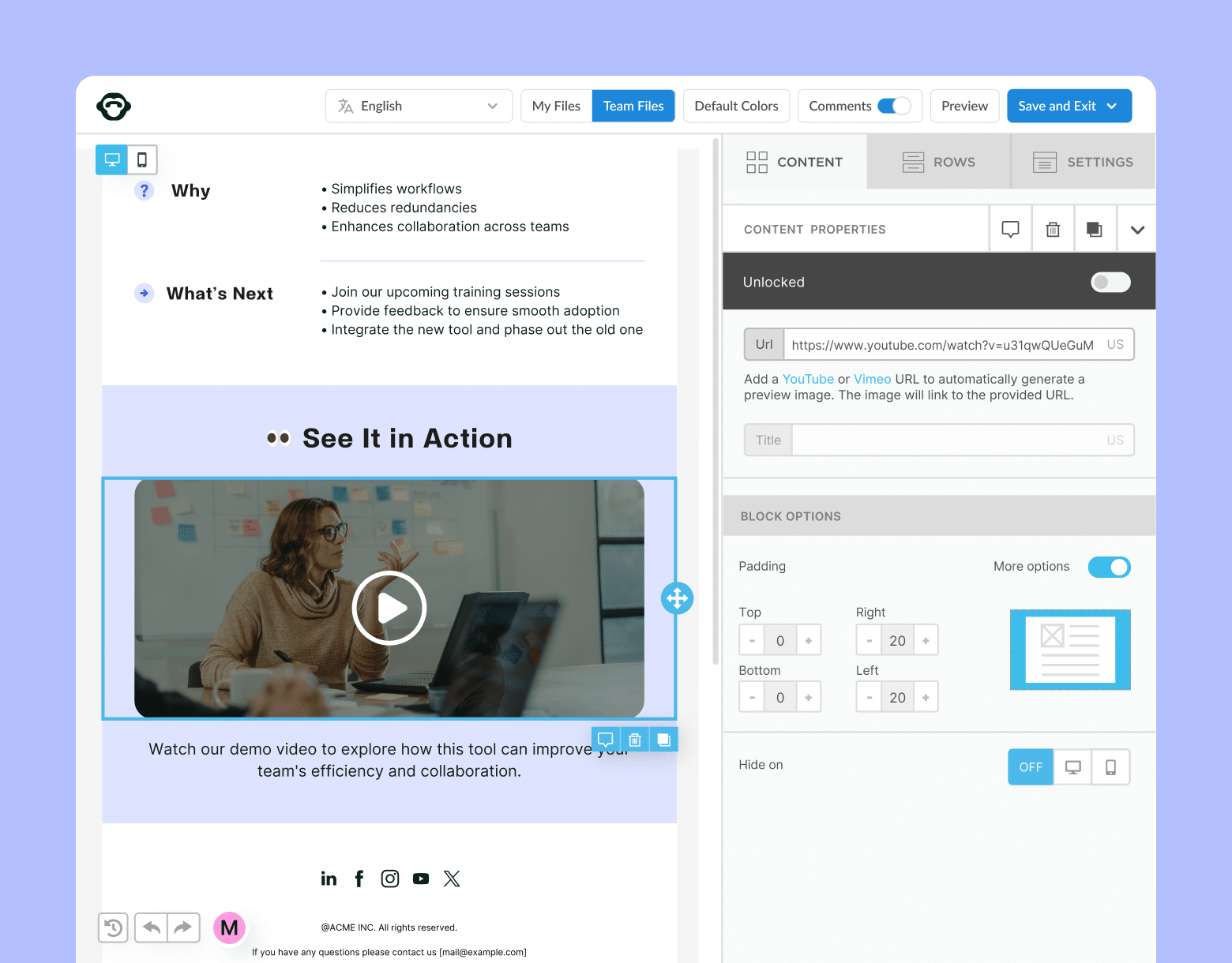
What Are Employee Feedback Surveys?
Employee feedback surveys are sent to workers in an organization to ascertain how they feel about their company, roles, teams, and managers. These surveys can be lengthy and cover a broad range of topics or very targeted, i.e., seek to find out employee attitudes about one specific aspect of the company.
Some employee feedback survey examples include:
- Employee engagement feedback surveys collect insights on employee satisfaction and motivation, trying to identify areas where employees can feel more connected to their work.
- Employee performance feedback surveys are used during organizational performance reviews to conduct employee self-assessments and gather information for decisions on progression, salary, titles, and bonuses.
- Employee onboarding feedback surveys are sent to new hires a set period of time after their start date to evaluate, improve, and refine onboarding processes.
- Employee exit feedback surveys are conducted during exit interviews to collect candid insights from departing employees.
- Employee experience feedback surveys ask workers to share their perceptions of their work environment, corporate culture, peer relationships, and other aspects of their day-to-day interactions within their organization.
Why Are Employee Feedback Surveys Important?
Getting regular feedback from employees helps organizational leaders stay tuned into what is happening in their companies.
Some key benefits of employee feedback surveys include:
- Identify problems: Asking employees to sound the alarm early when issues arise prevents minor concerns from escalating into major problems.
- Find impactful areas for improvement: Employee feedback can help employers ensure that resources are allocated efficiently for maximum impact.
- Reinforce organizational strengths: Recognizing what employees appreciate about the organization helps maintain and promote these positive aspects and even attracts like-minded talent.
- Refine internal processes: Employee insights provide valuable information for optimizing workflows and procedures.
- Make employees feel valued: Regularly soliciting feedback demonstrates that the organization cares about its employees’ opinions. Bonus point: act on the feedback in a timely and meaningful way, i.e., before soliciting more feedback.
- Prevent employee turnover: Addressing employee concerns and improving job satisfaction reduces the likelihood of turnover, retaining valuable talent within an organization.
Learn more on why employee feedback is so important in the modern workplace. Also, get a detailed look at why employee surveys are critical to getting staff feedback. Finally, learn more about employee feedback loops and why they are so necessary to get into place within an organization.
Create and send employee surveys for feedback
Engage staff with pulse surveys, eNPS surveys, reusable surveys, custom polls, and more. Ready to send modern emails?
Explore survey features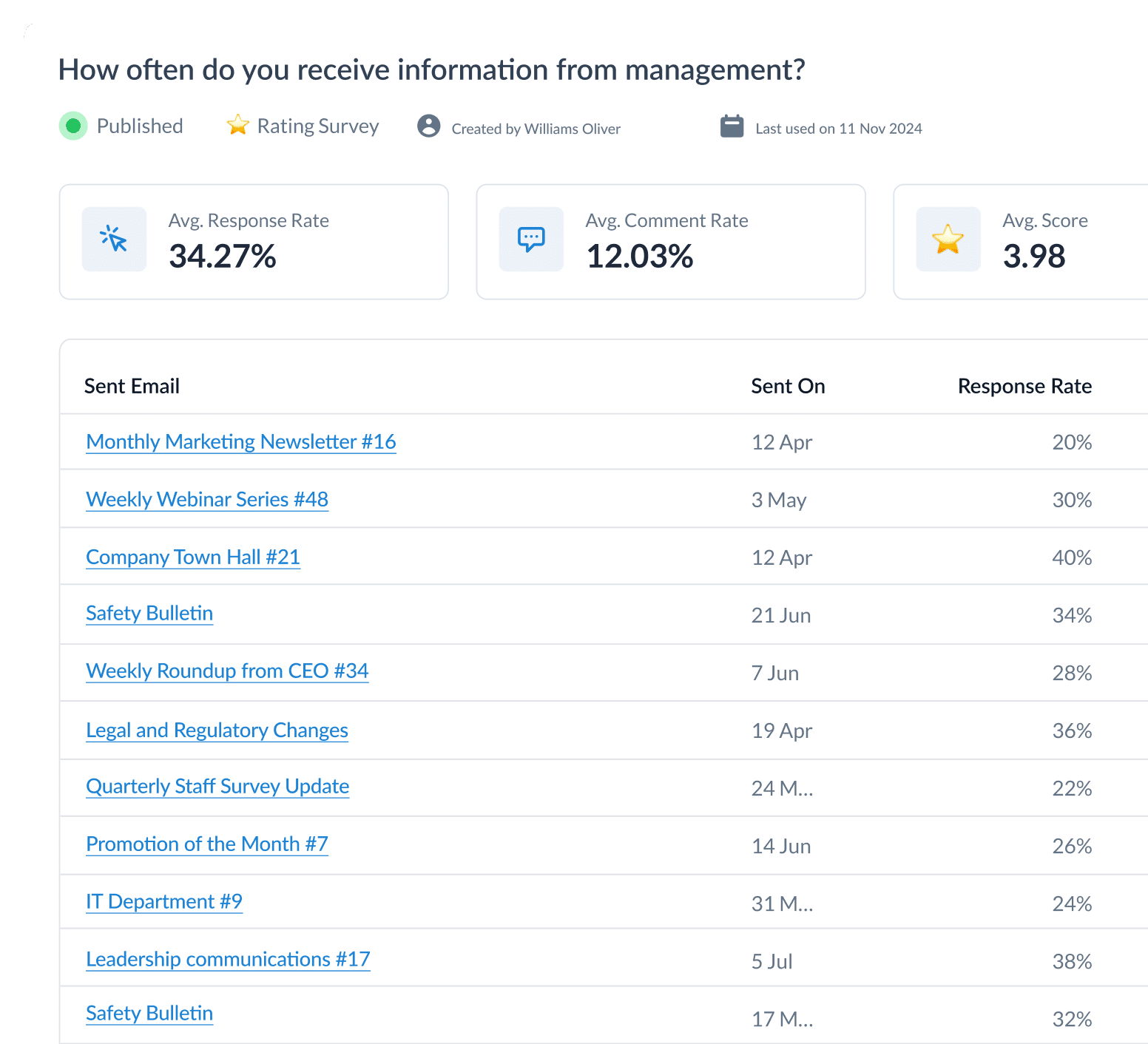
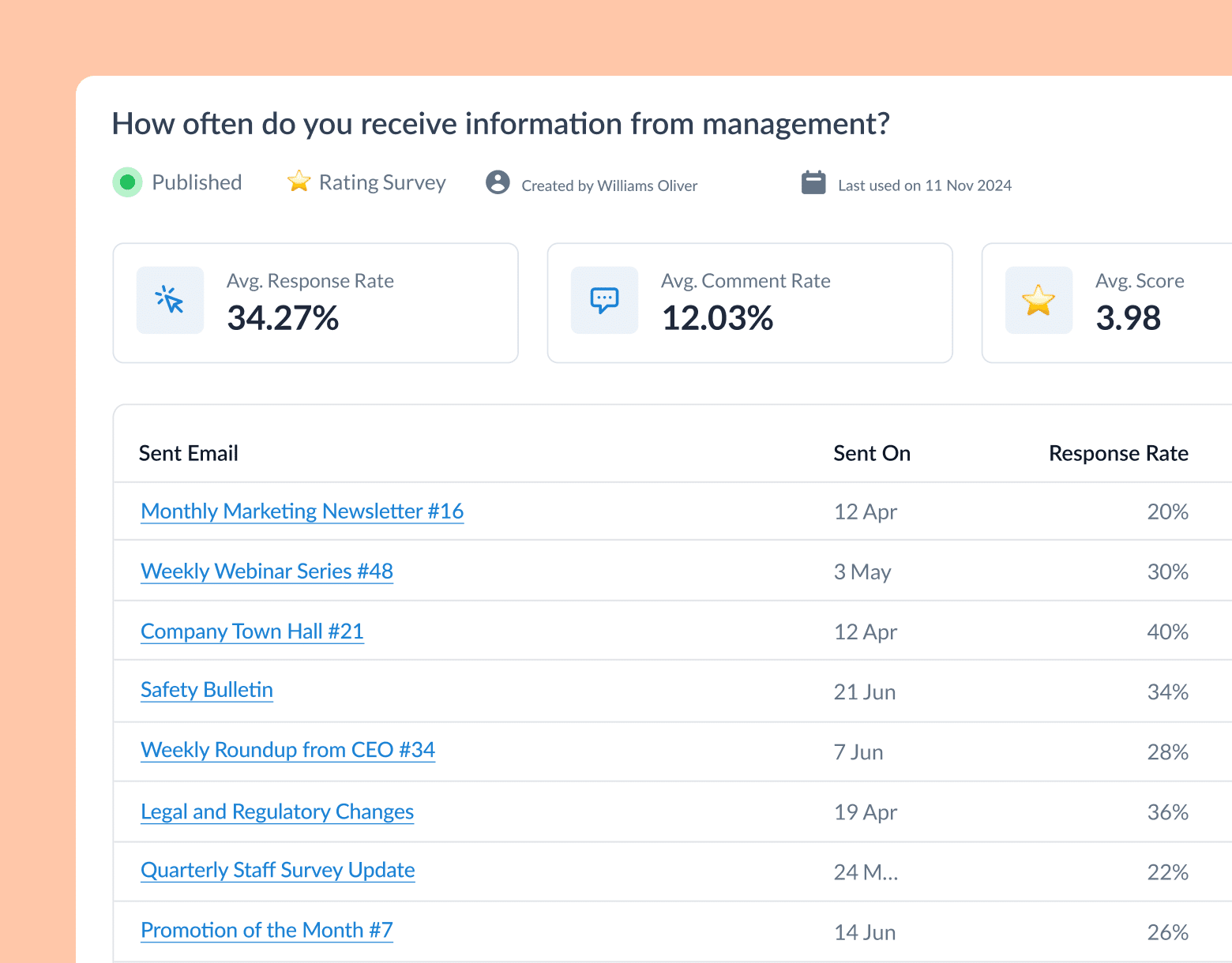
How to Write an Employee Feedback Survey
To get useful and accurate employee feedback survey answers, you’ll need to be strategic when writing your questions. How you word a question, the order of questions, and even the layout of the survey itself can skew respondents’ answers and make your results less accurate.
Understand your employee feedback survey intentions
Unclear or unfocused survey questions are unlikely to collect helpful information. Understanding what you want to find out will help you create questions that target that specific information.
Begin by defining your survey’s purpose. Are you looking to gauge employee satisfaction, identify areas for improvement, or measure employee engagement levels? Clear objectives will guide your question creation process, ensuring each question serves a specific purpose.
Word your employee feedback survey questions carefully to reduce bias
The wording of your survey questions has an immense impact on the responses received. Make sure your questions are clear and easy to understand for every respondent. Take care that you don’t conflate two questions into one. For example, asking, “How satisfied are you with your workload and team support?” can frustrate respondents who have different feelings about each.
You should also avoid asking leading questions, i.e., questions that make it clear that the surveyor prefers one answer over another.
For example, asking employees whether they agree or disagree that their manager has done “a good job managing your team’s workload” creates an obvious suggestion of what the preferable response would be. This puts pressure on the employee to answer accordingly.
If, on the other hand, you ask employees to estimate how often their team can meet their deadlines, you are asking for a quantitative answer that will likely be more accurate.
Select appropriate survey answer formats
When choosing the format of your survey, select answer formats that fit your questions and the type of information you’re trying to collect.
If you’re asking employees to answer on a scale, ensure the scale is balanced and includes a neutral option, like “I don’t know” or “Not applicable.” This gives employees a way to skip questions they don’t feel strongly about or don’t have an answer to rather than giving up or answering falsely.
Bonus tip: to avoid confusion, keep your response scales consistent throughout the survey. For example, a slider should always have 3 or 5 options (with a neutral response in the middle).
Consider question context and survey formatting
How questions are presented can be nearly as important as what the questions ask.
For example, while it can make sense to group related questions together, it can also unintentionally lead employees to bring context from previous questions when answering subsequent ones.
For example, let’s say you ask employees a series of questions about the office environment. Then, you ask them to rate the factors that influence their level of engagement from one to five.
If “office environment” is one of the options on the list, recency bias might lead employees to rate it higher, even if it wouldn’t usually be their top answer.
This also happens when you break up your survey into sections, so make sure you understand and are intentional about how your newsletter layout influences the responses you receive.
Calibrate survey length
The length of your survey can significantly impact the response rate. A shorter survey is more likely to be completed, while a longer one might be abandoned halfway.
To encourage responses, keep your survey concise and focused. Aim for a balance between collecting necessary information and respecting your employees’ time.
If you need to gather extensive data, consider breaking the survey into smaller parts or conducting it in phases. And if you do send out an extensive survey, make sure you do so infrequently. If you need further answers throughout the year, we recommend sending out regular pulse surveys to collect additional data. Check out this post to learn how to create a pulse survey that is effective.
Make sure responses are anonymous
When surveying employees, assure them that their answers will remain confidential and that there will be no negative repercussions for candidness.
Make sure that you’re using anonymous employee feedback survey tools that don’t track identifiable information. Clearly communicate the anonymity policy in the survey introduction to build trust and increase participation rates.
Survey regularly and track responses over time
Employee feedback should be an ongoing process rather than a one-time event! Regular surveys help track changes in employee sentiment and identify shifting trends.
This ongoing approach allows you to address issues promptly and make continuous improvements. It also means that you can find alternate angles on a topic to confirm that previous answers were accurate and unbiased.
Watch ContactMonkey LIVE in action
Join live demo
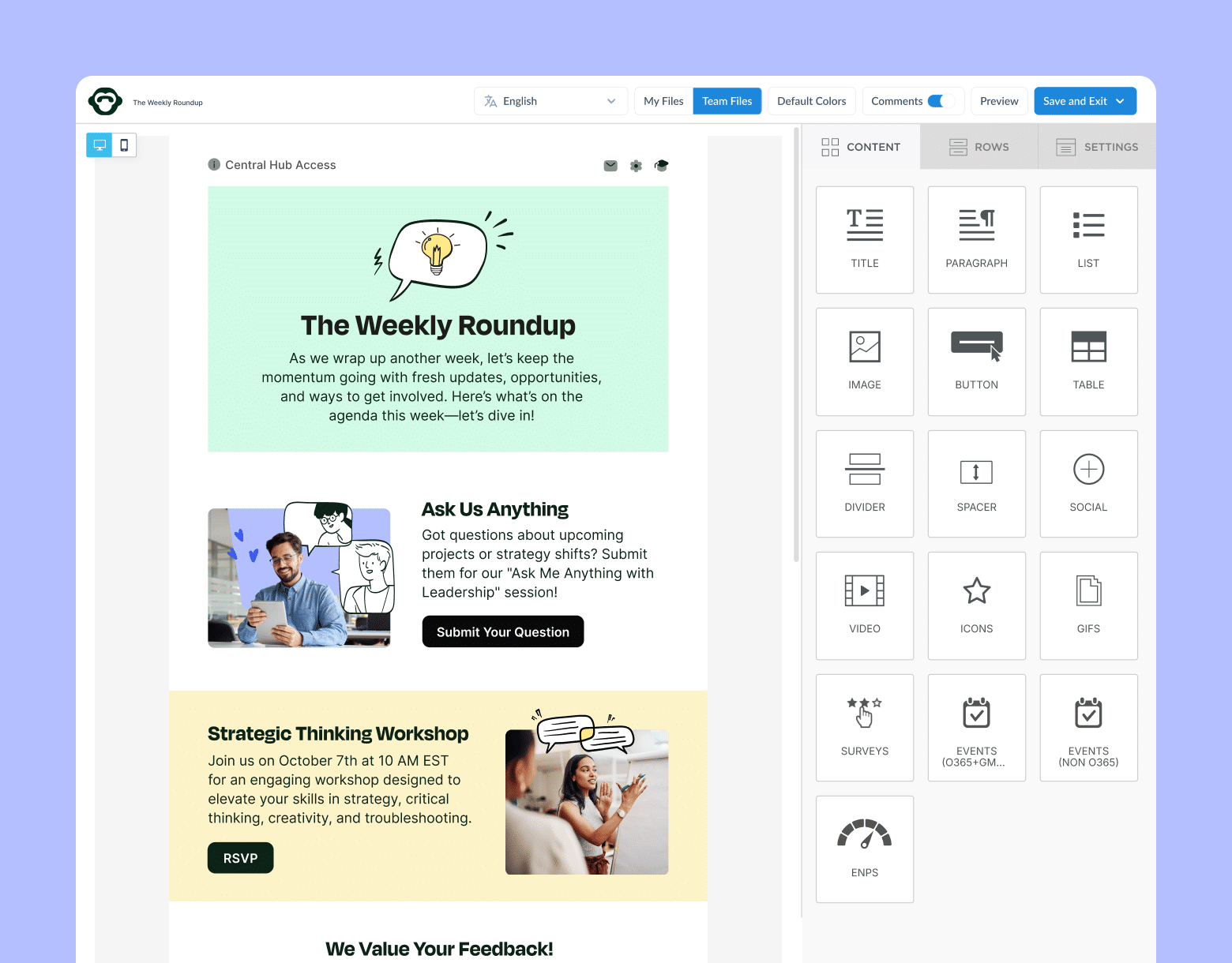
What Employee Feedback Survey Questions Should You Ask?
As we’ve noted, the best survey questions to ask your employees depend on your organization and the specific information you’re seeking.
There’s no one-size-fits-all survey question that will perfectly provide you with all the employee feedback you need. However, these sample questions can help you get a start on building your staff survey:
Questions for Gauging Employee Engagement
- How satisfied are you with your current role and responsibilities?
- How often do you feel stressed or overwhelmed at work?
- Do you have the resources and support needed to perform your job well?
Questions for Assessing Team Culture
- Do you feel comfortable sharing ideas and feedback with your team?
- How effectively does your team handle conflicts or disagreements?
- How often do you feel recognized for your achievements?
Questions for Gathering Feedback on Internal Communication
- Which of our communication channels do you find most useful?
- How frequently do you miss important internal updates?
- How difficult is it for you to find the information that you’re looking for?
Questions for Post-Onboarding Feedback
- How would you rate your onboarding experience?
- Did you feel adequately prepared to start your role after the onboarding process?
- What improvements would you suggest for the onboarding process?
Questions for Exit Interviews
- What prompted you to start looking for a new job?
- What could we have done to keep you with the company?
- What recommendations do you have for improving our workplace?
Think of these questions as a jumping-off point for surveys that gather comprehensive feedback, provide valuable insights, and drive improvements in your organization.
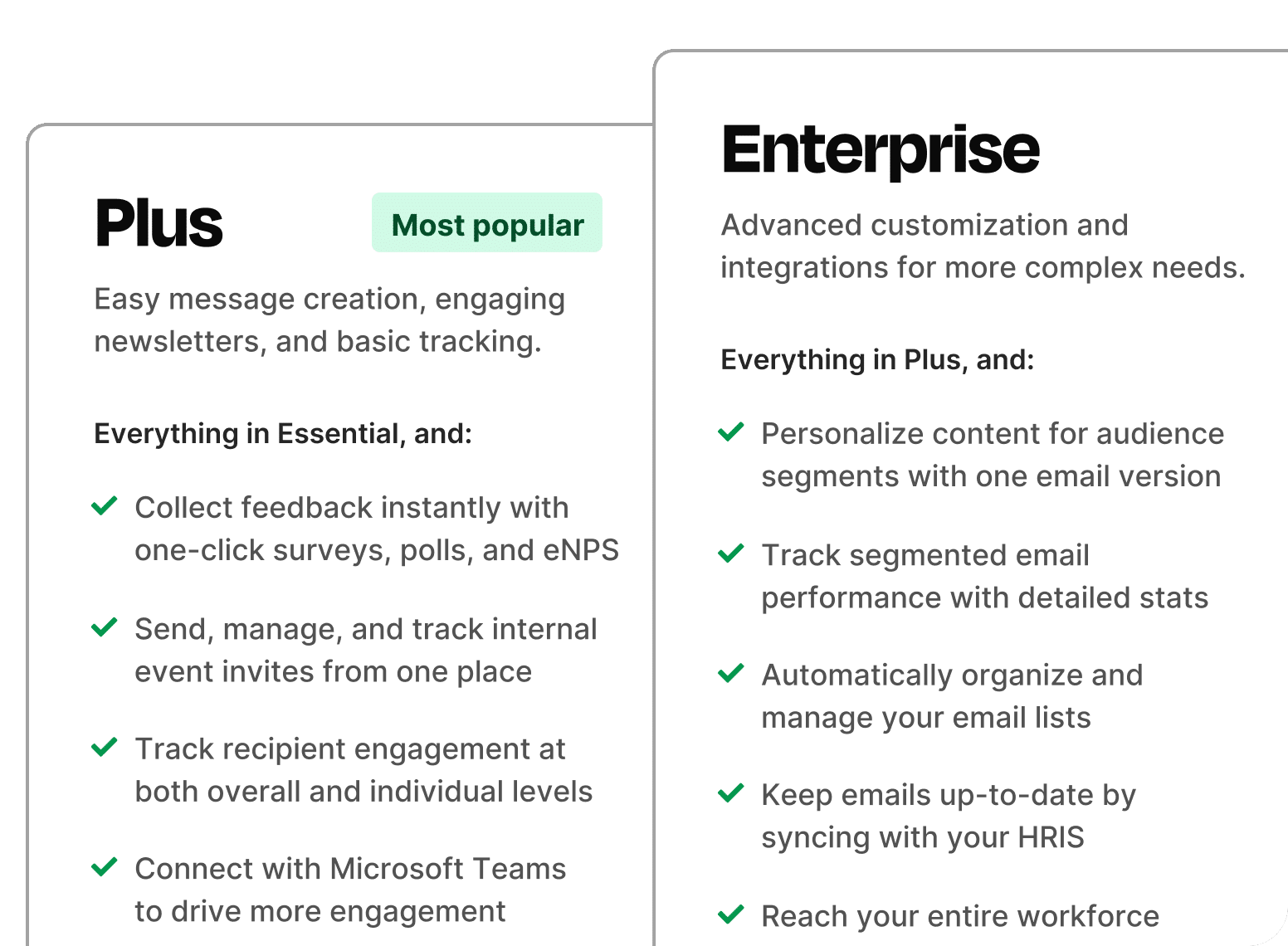
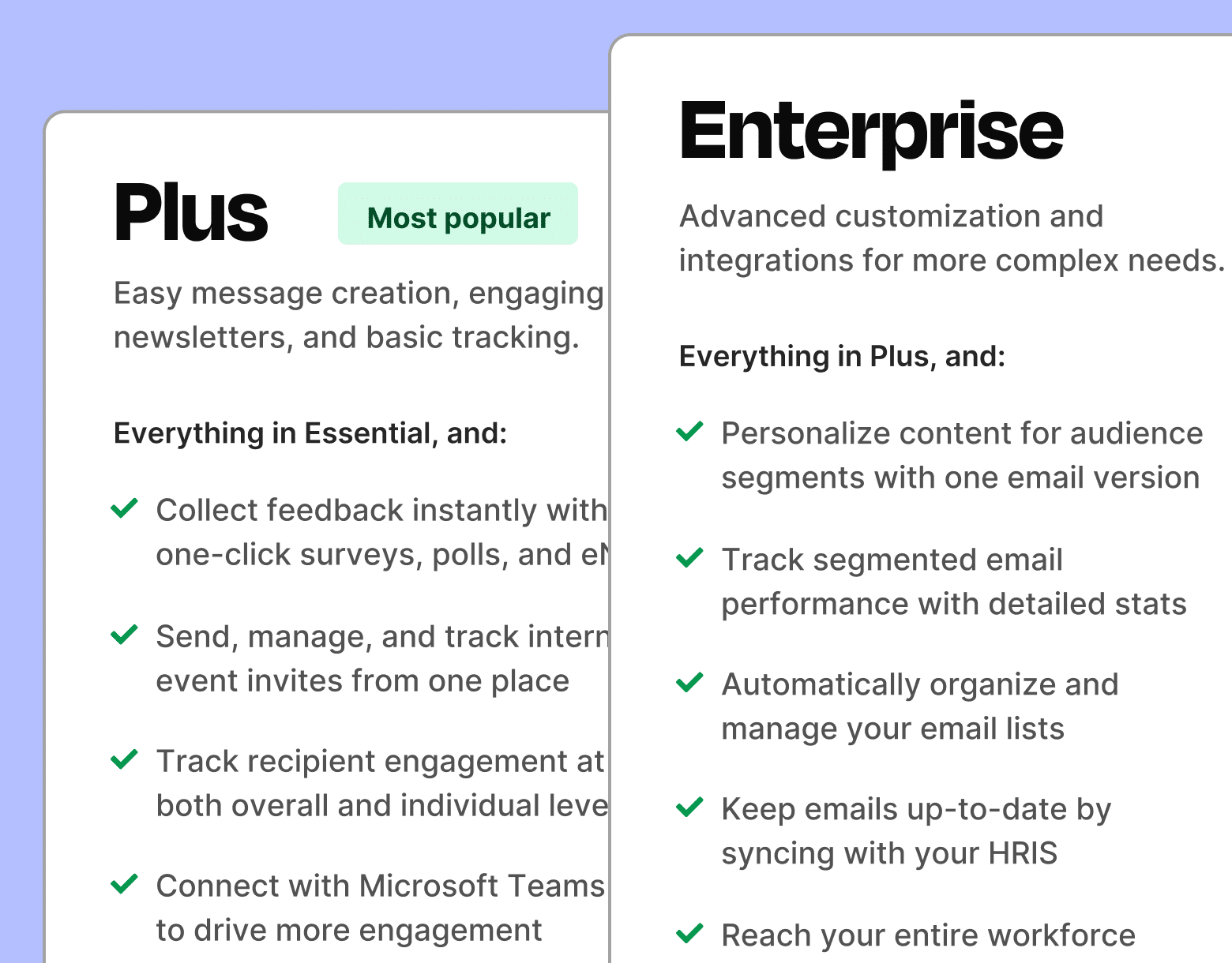
How To Create an Employee Feedback Survey
Once you’ve decided on your employee feedback survey questions, it’s time to create and send out the survey. To do this, we recommend finding an appropriate employee feedback survey tool or tools that make it simpler for employees to answer your questions.
Remember: different tools offer different functionalities, user experiences, and data-tracking capabilities. For longer surveys, you may need to use an external tool. But as we’ve already discussed, a long and thorough survey may not actually be the most useful for your needs.
For shorter surveys, go with a tool that integrates into your existing communication channels, such as ContactMonkey. ContactMonkey allows you to embed pulse surveys directly into the employee emails you’re already sending, such as weekly newsletters or HR updates. It’s the perfect solution for getting answers to pressing questions in a timely manner.
Using ContactMonkey’s drag-and-drop email builder, you can create striking HMTL emails in minutes. To insert a survey, just drag a survey block wherever you wish it to go, such as yes/no to star ratings, emoji reactions, eNPS surveys, and more.
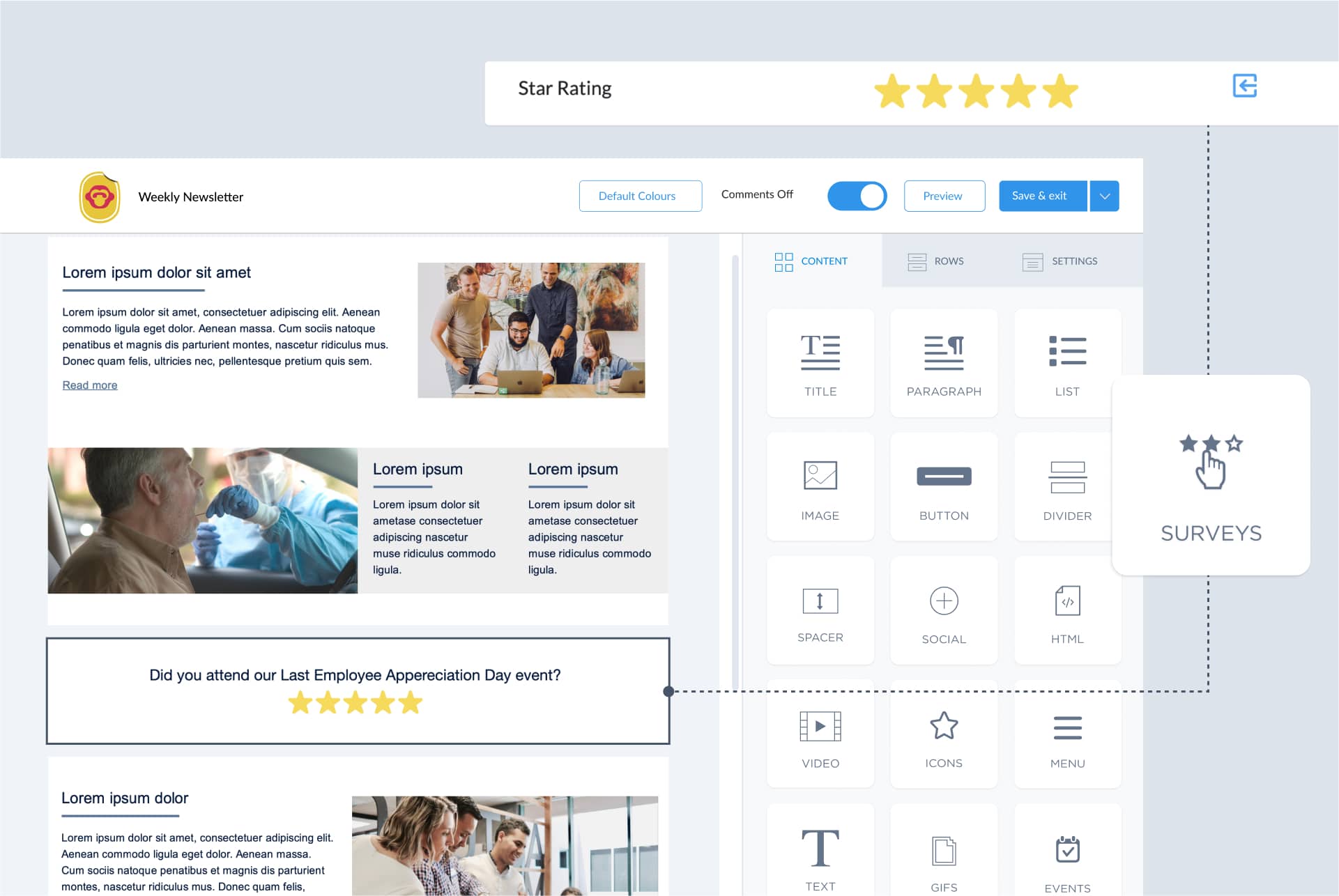
With ContactMonkey’s recurring survey feature, you can even build reusable surveys that can be added to multiple emails. Then, you can track changes in employee responses over time in one convenient dashboard.
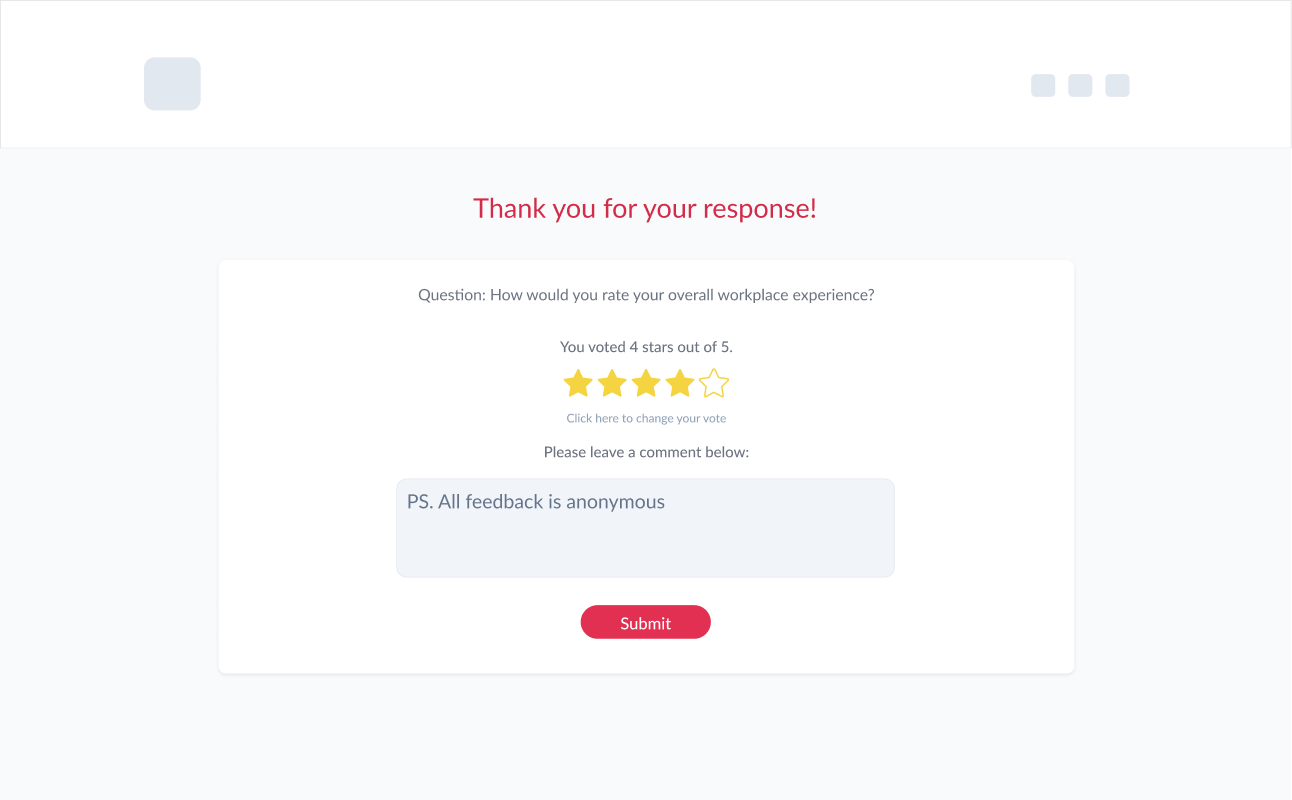
Enable anonymous comments to allow employees to add context and additional information alongside their employee feedback survey responses.
How to Analyze and Measure Your Employee Feedback Survey Results
Tools like ContactMonkey provide valuable insights into your staff survey results. ContactMonkey’s campaign dashboard offers a holistic view of survey data and email tracking metrics. These metrics enable organizations to measure the effectiveness of their feedback initiatives.
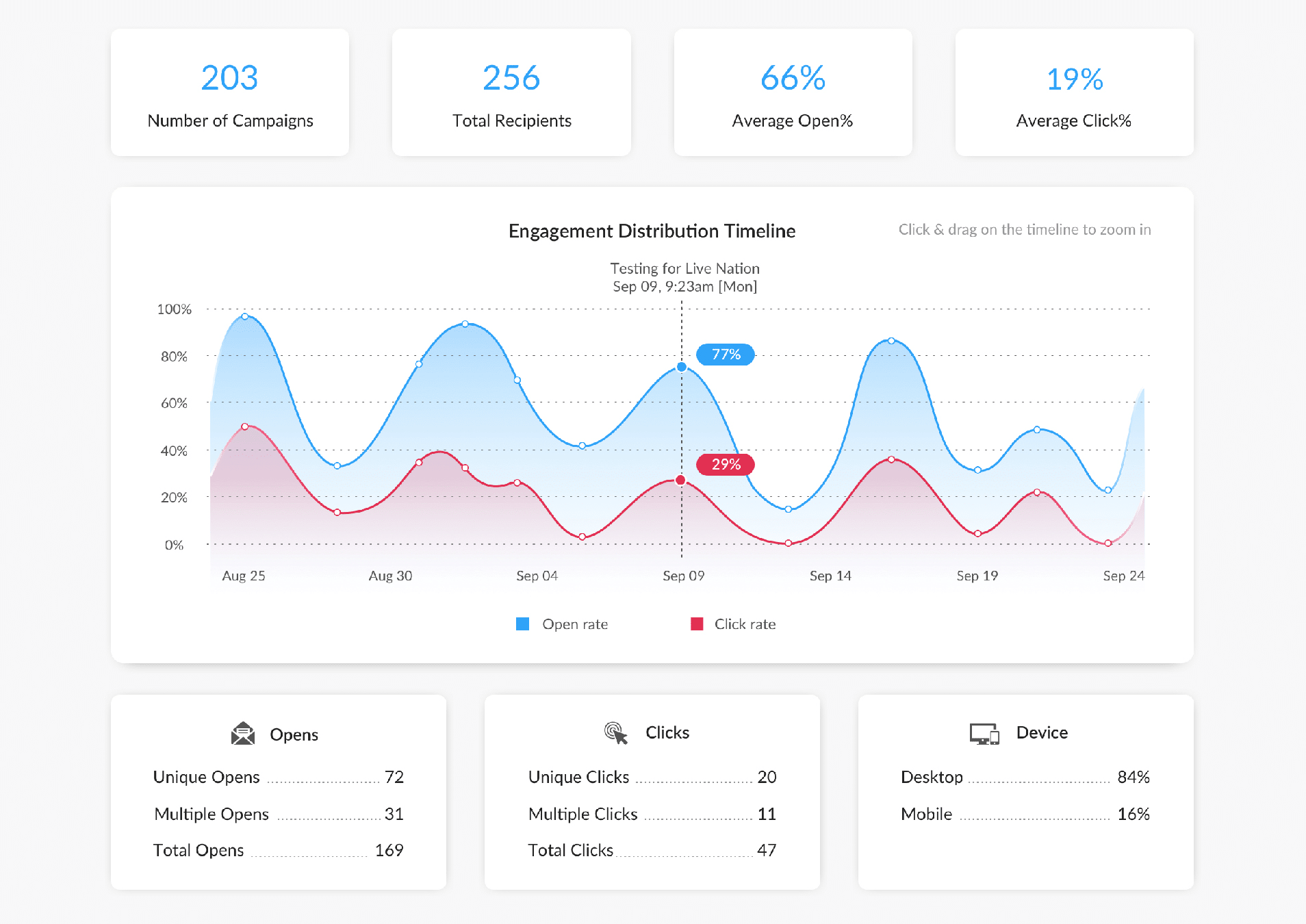
Survey Response Analysis
Within ContactMonkey’s analytics dashboard, you can examine employee feedback survey responses and anonymous comments to gain a deeper understanding of employee sentiments. The platform will even automatically calculate eNPS scores for you.
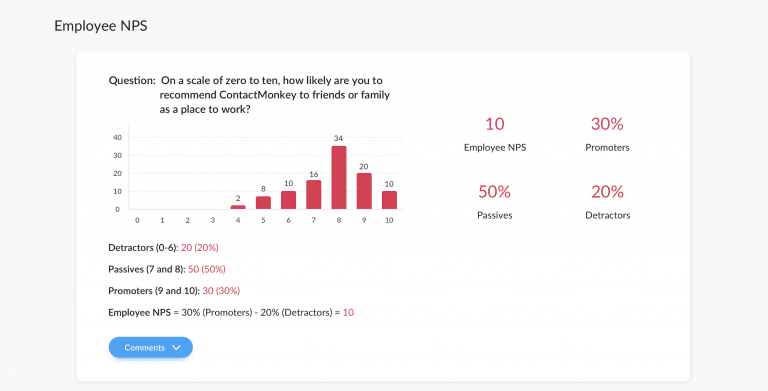
Plus, with recurring surveys, you can monitor trends and track improvements in employee satisfaction or changes in employee sentiment over time.
Learn more about the next steps after receiving the results of your employee engagement survey. Then, move on to our guide that outlines how to improve employee feedback over time.
Start two-way conversations and employee feedback loops
Learn how to engage staff with pulse surveys, content ratings and reactions, custom polls, and more. Ready to send modern emails?
See engagement features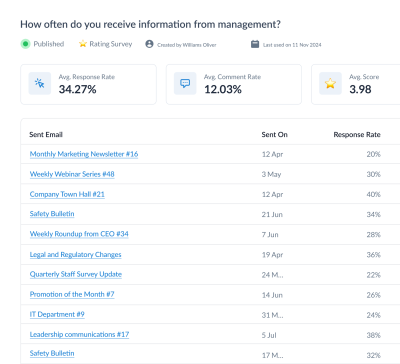

Email Performance Insights
In addition to survey data, ContactMonkey provides detailed email analytics. Choose between overall, individual, and anonymous tracking to see clicks, opens, read times, and more for every email you send.
Your email metrics offer contextual information on the performance of pulse surveys. Low response rates? Examining open rates and read times helps you identify employees who may have missed the survey email.
With individual tracking, you can download a list of employees who haven’t opened your survey and retarget these individuals for optimum survey outreach.
You can also segment your analytics to see how your emails landed with different teams, at different organizational levels, in different offices, or any other employee segments.
Get the Responses You Need From Your Employee Feedback Surveys With ContactMonkey
Creating effective employee feedback surveys requires careful consideration and strategic planning. From understanding the purpose of your survey to crafting well-worded questions and choosing appropriate answer formats, each step is crucial in gathering valuable and actionable feedback!
But the right employee feedback survey tools can also make a significant difference. Integrated survey tools like ContactMonkey can streamline the process, making it easier to collect, track, analyze, and act on employee feedback.
By combining these employee survey questions and best practices with the right survey platform, you can roll out your employee survey feedback action plan in no time.
Sign up for a free demo of ContactMonkey and start crafting employee surveys that unlock crucial insights into creating a more engaged and productive workplace.

